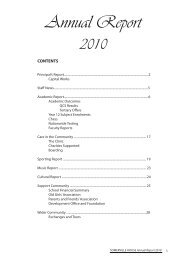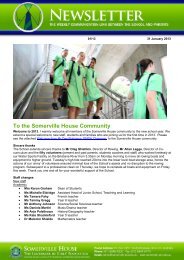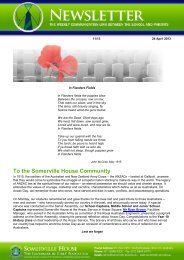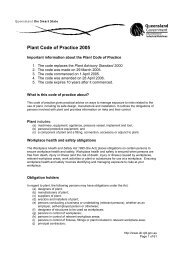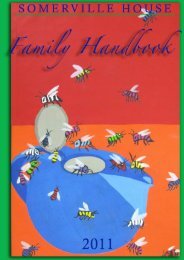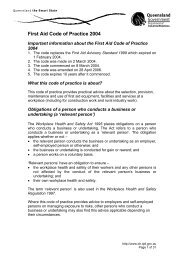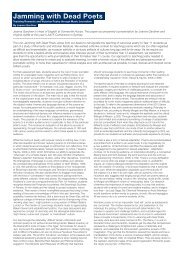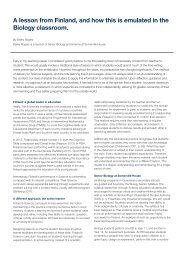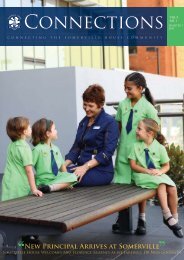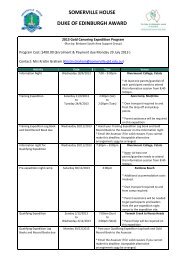To the Somerville House Community
To the Somerville House Community
To the Somerville House Community
Create successful ePaper yourself
Turn your PDF publications into a flip-book with our unique Google optimized e-Paper software.
Students learn that <strong>the</strong>y are able to achieve more within a supportive group than if, as individuals, <strong>the</strong>y attemptedto confront personal fears in isolation. Team building is an important medium for enhancing personal confidenceand contributes to lasting relationships that are <strong>the</strong> basis of community living. Students are able to experience newsocial influences which are different from <strong>the</strong>ir normal associations with family and friends. Outdoor educationexperiences promote positive inter-relationships with o<strong>the</strong>r students and teachers in order to foster productivelearning situations built on mutual respect.Living in an outdoor education environment also helps to promote <strong>the</strong> ‘three Cs’, those being:• Consideration – thoughtfulness for o<strong>the</strong>r students and staff;• Co-operation – working with o<strong>the</strong>r students to achieve common goals; and• Compromise – willingness to settle possible differences of opinions by making concessions.Outdoor physical pursuits assist with <strong>the</strong> development of individual fitness and co-ordinated movements. They alsodevelop an awareness of students’ strengths and weaknesses, and <strong>the</strong>refore, help to set realistic goals for ongoingimprovement.Just as students in outdoor programs may at times be anxious, <strong>the</strong>y should also experience joy, laughter andanticipation. Activities that are designed to provide satisfaction and exhilaration give participants opportunities toview <strong>the</strong>mselves as physical beings.Outdoor activities provide opportunities to broaden students’ interaction with different environmental conditions.Research suggests that outdoor experiences stimulate interest in <strong>the</strong> natural environment and <strong>the</strong>y have asignificant impact on students’ awareness of, and attitude towards, environmental issues.Intrinsically, camps carry some risks, and it is primarily <strong>the</strong> Schools’ responsibility to reduce <strong>the</strong>se to an absoluteminimum. Schools and providers cannot remove all risks entirely, however, and if this were possible, <strong>the</strong>elimination of <strong>the</strong> sense of challenge would diminish learning experiences.Consequently, risk management is an integral part of planning for outdoor education at <strong>Somerville</strong> <strong>House</strong>. Campsitesare well established and equipped appropriately for <strong>the</strong> respective Year levels. On-going checks are made of<strong>the</strong> facilities and activities offered, as well as <strong>the</strong> accreditation and qualifications of instructors. Modern airconditionedbuses equipped with seat belts are used to transport students.Parents must provide up-to-date medical information and advice about <strong>the</strong>ir daughters to <strong>the</strong> School beforestudents are permitted to attend camps. Where necessary, <strong>the</strong> taking of medication by students is controlled andsupervised strictly by staff.O<strong>the</strong>r features that aim to maximise learning outcomes and reduce risks include:• comprehensive planning occurs and information is conveyed clearly to all students, parents and staff;• students and staff are briefed before camps, especially on issues that relate to hygiene and safety;• <strong>the</strong> dos and don’ts are conveyed clearly to students so that <strong>the</strong>y are well aware of School expectations;• appropriate levels of adult supervision with adequate levels of training and qualifications are provided throughoutcamps;• <strong>the</strong> respective Head of Year is assigned to monitor and co-ordinate <strong>the</strong> activities at each camp;• all reasonable steps are taken to ensure <strong>the</strong> health and safety of students and staff attending camps; and• reviews are conducted at <strong>the</strong> conclusion of camps to identify any issues or concerns. Changes may <strong>the</strong>n berecommended and implemented for future camps.In conclusion, through <strong>the</strong> outdoor education program, Middle School students are provided with experiences tohelp <strong>the</strong>m become more knowledgeable about <strong>the</strong> environment and <strong>the</strong>ir place in it. Participation in outdoorpursuits supplies students with additional opportunities for challenge, adventure and excitement. Perhaps, most ofall, <strong>the</strong> activities offer chances for students to explore and shape <strong>the</strong>ir values and attitudes within a residentialcommunity of peers and adults.5



